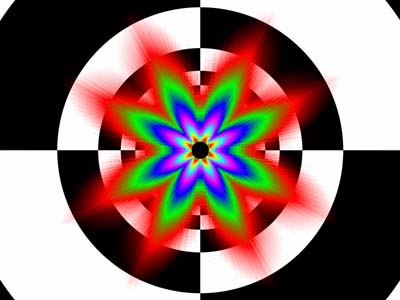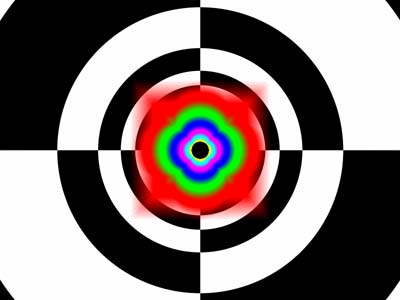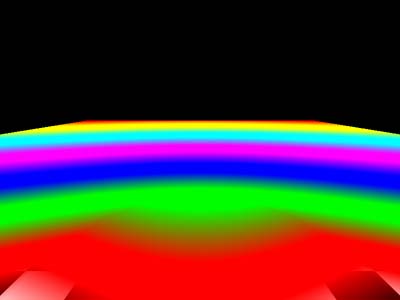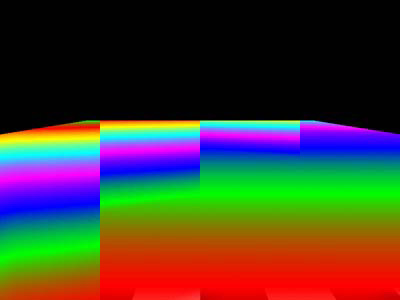Image Quality Analysis Fall 2003: A Glance Through the Looking Glass
by Derek Wilson on December 10, 2003 11:14 PM EST- Posted in
- GPUs
D3D AF Tester
For these tests, we used the D3D AF Tester that can be found at 3dcenter. Our tunnel test was taken by turning up the anisotropic filtering level to 8x and using full-colored mipmaps (all other settings were default). The plane tests were done using a distance of 15 and an angle of 75 degrees at each level of anisotropy and stage tested.  |
| ATI Tunnel 8x Anisotropic Filtering (Click to enlarge.) |
 |
| NVIDIA Tunnel 8x Anisotropic Filtering (Click to enlarge.) |
We can see the affect of ATI's weighted Manhattan distance calculation on the tunnel test. The LOD calculation is heavily dependent on x and y positions. This really gives us a good idea of just how different NVIDIA and ATI GPUs render textures. The resolution of the texture used varies a great deal with respect to the angle of the surface being textured. This means that just by rotating something around, the quality of the filtering being used is compromised (a smaller resolution texture than needed will be used). As there is a lot of interpolation going on here and horizontal and vertical surfaces are very common, the effects aren't particularly noticeable in game play. Of course, this helps to explain why in some screenshots, NVIDIA's textures look sharper than ATI's, while in others, ATI's textures look sharper than NVIDIA's.

ATI filtering differences (hold your mouse over the image for Control Panel Stage 1)

NVIDIA filtering differences (hold your mouse over the image for Control Panel Stage 1)
Here, we are looking at the differences in AF set by the control panel at stage 1 (we don't start with the highest resolution mipmap) and application controlled filtering at stage 0. With ATI, we can see that the card doesn't do either anisotropic or trilinear filtering when looking at any texture stage other than 0. We haven't been able to verify the exact impact of this optimization in a game, so we aren't really able to comment on the real world image quality implications of this.

From left to right: trilinear, 2xAF, 4xAF, 8xAF filtering (hold your mouse over the image for NVIDIA results)
We can see the differences between trilinear and the different levels of anisotropic filtering on the plane test. Anisotropic filtering is able to use higher resolution textures better at greater distances when the texture is at an angle to the viewer. Also, the differences between levels (2x, 4x, and 8x) of anisotropic filtering can be seen. Enabling a higher level of anisotropic filtering extends the distance from the viewer at which anisotroic filtering stops and trilinear filtering starts.
From these pictures, it is also evident that NVIDIA does more bilinear filtering when texels are near screen pixel sizes. This has been dubbed “brilinear” filtering by some, as the method blends bilinear filtering more heavily than usual into higher order filtering techniques. We have yet to see any perceptible image quality issues arise from this, and as long as banding is not evident and the highest possible resolution textures are used, this filtering method serves its purpose. NVIDIA assures us that if we can point out a loss in image quality in any game, they will correct it.










35 Comments
View All Comments
retrospooty - Thursday, December 11, 2003 - link
I have been visiting Anandtech for well over 4 years , and I have often exclaimed how thorough, fair, and unbiased this site is to others...This is the first article I have ever read here that I think is complete poop. I cannot beleive that in any fair IQ test Nvidia came anywhere close to ATI. Either the author is not being honest, or is color blind. Anyone with eyeballls can compare the two and see that ATI is much sharper, and vibrant especially with AA... Nvidia is WAY blurry.
I am very VERY dissapointed in this. :(
TheGoldenMenkey - Thursday, December 11, 2003 - link
Excellent article. I would much rather be taught why things are different than be showed some differences in rendering and then have someone declare which one is cheating. Thanks for teaching us enough to let us come to our own conclusions. Keep up the good work AT.tazdevl - Thursday, December 11, 2003 - link
Better look @ that... then we might have something to discusshttp://www.anandtech.com/video/showdoc.html?i=1931...
dvinnen - Thursday, December 11, 2003 - link
Artical seemed fair and unbias to me. Your AA and AF question is odvious. Look at the URL of the png file. It clearly states what is on.It seems they have cleaned up there DX9 proformance, but they still treat synthitic benchmarks badly. Most recintly the 3DMark03 patch a month ago and how they handeled the media (PR on one side of the pond said one thing, on the other saide, they said another)
tazdevl - Thursday, December 11, 2003 - link
So Derek to you own stock in nVIDIA? Did Brian Burke write this for you?Were AA and Aniso used in all tests or a few? Which ones? What modes are we comparing against which benchmarks?
Ever thought that BOTH nVIDIA and ATI can fix the outstanding instead of just nVIDIA?
I swear, every since Anand got caught up in the whole NV30 fiasco, the site's credibility is worth absolutely squat when it comes to nVIDIA.
I'm not saying ATI is without faults, but let's try to appear unbiased at a minimum in the article.